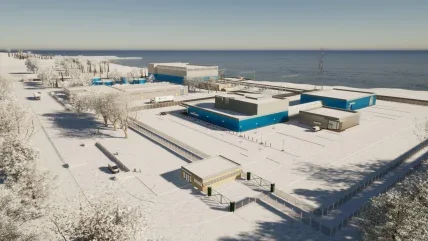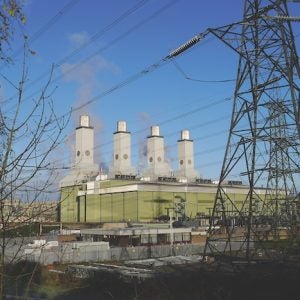
The FLEX reactor is the thermal spectrum version of Moltex Energy Limited’s globally patented SSR technology – it uses graphite as the moderator. The SSR technology (MPS, January 2017, pp 22-26) is shared with MoltexFLEX’s sister company, Moltex Energy Canada, which is developing the fast spectrum version (the SSR-W) and the WAste To Stable Salt (WATSS) process that will produce the fuel for the reactor from recycled spent fuel.
SSRs are fundamentally unique in comparison with all other molten salt reactors in that they restrict the radioactive fuel salt to tubes similar to the fuel assemblies in conventional reactors. A separate, non-radioactive molten salt then transfers heat from the reactor core to heat exchangers.
In other molten salt reactors, where the fuel is also the coolant, the complex fuel salt circulation system – with pumps, filters, conditioning units and heat exchangers – is exposed to the radioactive fuel salt. This puts severe demands on those components and makes maintenance challenging, and these engineering challenges arguably represent the key reasons that these reactors are not currently used commercially.
Simple solution
The FLEX reactor is an evolution of the company’s earlier thermal spectrum design, the SSR-U. MoltexFLEX was launched in September 2022 in the UK to promote the FLEX design worldwide and develop SSR technology.
The FLEX reactor is designed with simplicity in mind. It is small and modular, allowing most components to be factory-produced, enabling transportability, reducing on-site work and speeding up construction, all of which minimise the overall costs. It is a low-pressure design that uses natural convection for all heat transfer – this removes the need for pumps or any other moving parts, and for expensive high pressure containment structures. Wherever possible, the FLEX reactor will use materials and technology already proven within the nuclear industry, making safety and design substantiation quicker and easier by eliminating the need for extensive research programmes.
MoltexFLEX’s key objective is to bring the FLEX reactor to market quickly, rapidly deploying fleets worldwide. This is one of the reasons for the selection of low-enriched uranium as a feedstock for the fuel – this material is available now and is generally accepted round the world without the development of new safeguard protocols. The company aims to produce its first-of-a-kind plant by the end of the decade.
The FLEX reactor is inherently and passively safe. The design philosophy centres on reducing or eliminating hazards through the fundamental characteristics of the technology, along with passive measures to manage residual risks. It relies on inherent safety features such as the containment of volatile fission products as salts within the fuel salt, and passive control systems such as the expansion and contraction of molten salt with temperature to insert or withdraw neutron poison from the core to control the reactor. This approach offers a considerable advantage over other reactor technologies, which rely far more heavily on active safety systems with complex backup systems to ensure reliability of operation.
The FLEX reactor has been developed to provide energy at a cost comparable to that of burning fossil fuels. Furthermore, its high temperature, 750°C, output offers the potential for higher-efficiency energy conversion as technologies such as supercritical CO2 turbines mature. Given the vast challenge involved in deep decarbonisation, the ability to produce high temperature heat cost effectively will be as important as producing low-cost electricity.
Complements renewables
The output temperature of the FLEX reactor enables cost-effective storage of thermal energy in the molten salt GridReserve® system for hours or days. This energy can be released when demand outstrips supply, enabling the FLEX and GridReserve® system to complement intermittent renewable energy by rapidly responding to changes in demand and providing dispatchable generation to address dips in output. For technical and economic reasons, conventional nuclear plants are less able to provide this flexibility.
The FLEX reactor’s output heat can be directly used for on- and off-grid electricity generation or for downstream applications, including:
- direct heat for district heating or industrial processes (as much as two-thirds of all heat use in European industry is below 700°C);
- high-temperature electrolysis to produce clean hydrogen (the FLEX reactor can also support more efficient thermochemical production of hydrogen); and
- as a power source for water desalination plants.
Additionally, the FLEX reactor can be reconfigured for marine applications, principally for ship propulsion.
Flexible in deployment
A FLEX reactor outputs 40 MWt, equivalent to 16 MWe; heat can be produced at a levelised cost of £10/MWh, whereas electricity can be produced at approximately £30/MWh. Each reactor has a ground footprint similar to that of a typical three- bedroom house. They can be deployed singly or in arrays of any number to provide energy at the gigawatt scale. For example, an array of 32 units may be deployed in combination with the GridReserve® thermal storage facility to deliver 1.5 GWe for eight hours of peak demand.
The heat output is passed using molten salt heat exchangers to the GridReserve® storage tanks, located outside the nuclear island. This stored heat can then be used to generate superheated steam to drive conventional turbines as used in conventional fossil fuelled power plants. This configuration is possible because, in contrast to conventional reactor designs, the safety of the FLEX reactor is completely independent of the heat sink provided by the heat storage and power generation plant.
Inside the reactor
Both the fuel – a low-enriched uranium fluoride – and primary coolant consist of molten salt, with corrosion controlled through the salts’ chemistry, preventing oxidation and leaching. The fuel salt is contained in steel tubes, each placed in a separate channel in a graphite matrix moderator, forming the reactor core. The core sits within the reactor tank vessel, which is filled with primary coolant. The vessel is placed in a concrete pit underground and covered with a concrete shield. Convection circulates the molten fuel salt within the fuel tube, with heat transferred through the tube wall to the surrounding coolant.
During normal operation, heat from the fuel is removed from the core by natural convection of the primary coolant salt within the reactor tank. Residual decay heat is continually removed by natural circulation of air around the tank. These passive mechanisms ensure that no active systems or pumps are required for heat removal or shutdown.
Latest development work
MoltexFLEX’s in-house development team has made considerable strides over the past year. For example, in concert with scientific instruments manufacturer Anton Paar, the company has recently installed a rheometer inside a climate-controlled inert gas glovebox at the MoltexFLEX laboratory in Warrington, Cheshire – an installation unique in the UK. Capable of measuring the viscosity and density of molten salts at temperatures up to 1000°C, the rheometer is now generating data on the behaviour of the proposed fuel and coolant salts for the FLEX reactor, material properties which have hitherto been little explored.
Additionally, MoltexFLEX is involving external partners in its research. Thanks to a grant from the Henry Royce Institute as part of the Industrial Collaboration Programme, the company is now collaborating with scientists at the University of Manchester’s Nuclear Graphite Research Group to characterise how molten salt interacts with standard industrial-grade graphite. Using industrial-grade synthetic graphite with high thermal and chemical resistance will deliver significant cost savings for the FLEX reactor.
MoltexFLEX is also demonstrating corrosion control of the alloys proposed for use within the reactor vessel and the fuel tubes. Corrosion of metals by molten salts is a long-standing problem in the industry. This is prevented in the coolant salt by dissolving small amounts of aluminium within it, which scavenges any oxidising agents before they can attack the metal.
The FLEX reactor uses a patented eutectic mixture of aluminium fluoride and sodium fluoride as primary coolant. Similar salt mixtures have seen decades of use in the aluminium smelting industry, giving high confidence in their lack of interaction with the graphite moderator. The fuel salt chemistry is redox stabilised by a combination of uranium oxidation states, acting as a redox buffer in a eutectic mixture with sodium fluoride diluent. The buffer enables maintenance of redox potential, and neutralisation of potentially corrosive fission products generated throughout the reactor’s life.
Alloy sample tubes containing fluoride salts have been heated to the FLEX reactor operating temperature of up to 900°C and maintained at that level for many months in the MoltexFLEX laboratory, at the end of which they exhibit little evidence of corrosion – even at the micron level when examined under a scanning electron microscope.
Looking ahead
MoltexFLEX is scaling up to build on the amazing progress the company has made over the past year, which will see multi-fold increases in the size of its team to several hundred internal and external staff over the next two years, and is currently having fruitful discussions with private investors to fund the next stage of development. While the company believes it can bring the first-of-a-kind FLEX reactor to fruition via private finance alone over the next six to seven years, it is eagerly awaiting the establishment of Great British Nuclear and the opportunity to work with them to establish advanced nuclear technologies such as FLEX in the energy mix. In the meantime, the company is increasingly gaining recognition for its ground-breaking technology – for example, in April it was named as a Champion as part of the Green Builders Of Tomorrow initiative, run by the UK Department for Business and Trade. This sees MoltexFLEX joining five other companies in travelling to the UAE to meet potential investors.
To conclude, MoltexFLEX believes that its SSR technology, and the FLEX reactor in particular, have a huge contribution to make – not just towards achieving Net Zero by 2050, but also in bringing abundant, clean and low-cost energy to the developing world and restoring Britain’s lead as a nuclear innovator. It’s this vision that drives the MoltexFLEX team every day towards making the FLEX reactor a reality.






